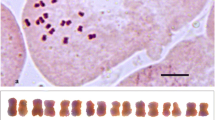Summary
Detailed microsporogenesis in 4 species of the genus Pennisetum namely P. typhoides (n = 7), P. longistylum (n = 18), P. polystachyon (n = 27) and P. pedicellatum (n = 27) was studied. Nature of chromosome pairing was critically studied and pairing was regular in diploid and allotetraploid species. Some multivalents formation occurred in segmental allopolyploids. They displayed numerous meiotic irregularities. Aberrant meiosis in the material is evaluated. The role of apomixis, hybridization and polyploidy in the evolution of the genus is discussed.
Zusammenfassung
Es wird über eingehende Untersuchungen der Mikrosporogenese in 4 Species der Gattung Pennisetum, nämlich P. typhoides (n = 7), P. longistylum (n = 18), P. polystachyon (n = 27) und P. pedicellatum (n = 27) berichtet. Die Art der Chromosomenpaarung wurde kritisch geprüft, sie war bei den diploiden und allotetraploiden Species regulär. Multivalentbildung trat in einigen Fällen bei Segment-Allopolyploiden auf, sie zeigten zahlreiche meiotische Unregelmäßigkeiten. In dem Material aufgetretene aberrante Meiosen wurden ausgewertet. Die Rolle von Apomixis, Hybridisation und Polyploidie bei der Evolution der Gattung wird besprochen.
Similar content being viewed by others
References
Bor, N. L.: The Grasses of Burma, Ceylon, India and Pakistan. Oxford: Pergamon Press 1960.
Borgaonkar, D. S., Harlan, J. K., Wet, J. M. J. de: Cytogenetic study of hybrids between Dichanthium annulatum and D. fecundum II. Proc. Okla. Acad. Sci. 42, 13–16 (1962).
Clausen, J.: Partial apomixis as an equilibrium system in evolution. Caryologia 6 (Supplement), 469–479 (1954).
Gustafsson, A.: Apomixis in higher plants. 1: The mechanism of apomixis. Lunds Univ. Arssk. N.F. Avd. 2. Bd. 43, 1–68 (1946).
Gustafsson, A.: Apomixis in higher plants. II. The casual aspect of apomixis. Lunds Univ. Arssk. N.F. Avd. 2. Bd. 43, 69–180 (1947a).
Gustafsson, A.: Apomixis in higher plants. III. Biotype and species formation. Lunds Univ. Arssk. N.F. Avd. 2. Bd. 43, 181–370 (1947b).
Hrishi, N. J.: Studies on the cytogenetics of six species of Pennisetum and their comparative morphology and anatomy. Genetica 26, 280–356 (1952).
Joshi, A. B., Patil, B. D., Manchanda, P. L.: Chromosome numbers in some grasses. Curr. Sci. 28, 454–455 (1959).
Khan, A. D.: Some suitable pasture and forage grasses for Uttar Pradesh. J. Soil Water Conserv. India 5, 169–173 (1957).
Krishnaswamy, N., Raman, V. S.: A note on the chromosome numbers of some economic plants of India. Curr. Sci. 18, 376–378 (1949).
Müntzing, A.: Genetic research, 345 pp. Stockholm: LTs Förlag 1961.
Müntzing, A., Prakken, R.: The mode of chromosome pairing in Phleum twins with 63 chromosomes and its cytogenetic consequences. Hereditas, Lund, 26, 463–501 (1940).
Nath, J., Swaminathan, M. S.: Chromosome numbers of some grasses. Ind. Jour. Genet. & PL Br. 17, 102 (1957).
Nordenskiöld, H.: Cytological studies in triploid Phleum. Bot. Not., 12–32 (1941).
Riley, R.: The diploidization of polyploid Wheat. Heredity 15, 407–429 (1960).
Riley, R., Chapman, V.: Genetic control of the cytologically diploid behaviour of hexaploid Wheat. Nature, Lond., 182, 713–715 (1958).
Riley, R., Chapman, V., Kimber, G.: Position of gene determining the diploid like meiotic behaviour of Wheat. Nature 186, 259–260 (1960).
Riley, R., Kempanna, C.: The homoeologous nature of the nonhomologous meiotic pairing in Triticum aestivum deficient for chromosome V (5B). Heredity 18, 287–306 (1963).
Riley, R., Chapman, V., Young, R. M., Belfield, A.M.: Control of meiotic chromosome pairing by the chromosome of homoeologous group 5 of Triticum aestivum. Nature 212, 1475–1477 (1966).
Sears, E., Okamoto, M.: Intergenomic chromosome relationships in hexaploid Wheat. Proc. 10th Int. Congr. Genet. 2, 258–259 (1958).
Singh, D. N., Godward, M. B. E.: Cytological studies in the Gramineae. Heredity 15, 193–197 (1960).
Stebbins, G. L.: Variation and Evolution in plants. New York: Columbia Univ. Press 1950.
Tateoka, T.: Chromosome numbers of some east African grasses. Amer. Jour. Bot. 52 (8), 864–869 (1965).
White, R. O.: The Grassland and Fodder resources of India. I.C.A.R. Scientific monograph No. 22, New Delhi, 1964.
Author information
Authors and Affiliations
Additional information
Communicated by Hans Stubbe
Rights and permissions
About this article
Cite this article
Sisodia, K.P.S. Cytological studies on some species in genus Pennisetum . Theoret. Appl. Genetics 40, 26–31 (1970). https://doi.org/10.1007/BF00280983
Received:
Issue Date:
DOI: https://doi.org/10.1007/BF00280983




